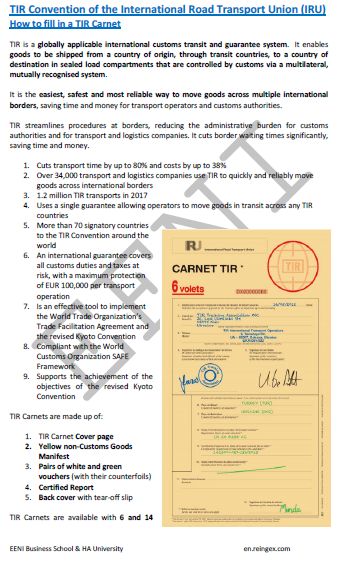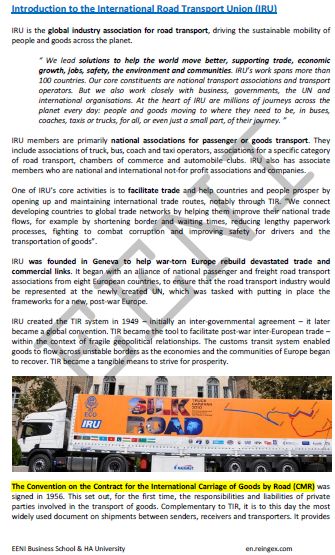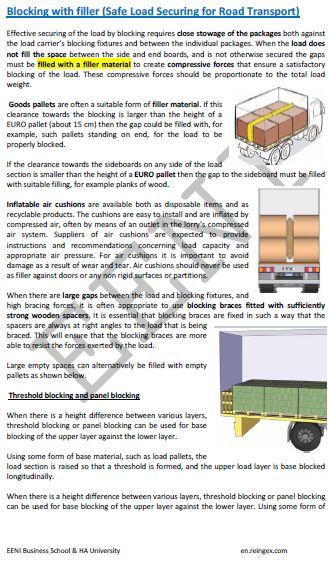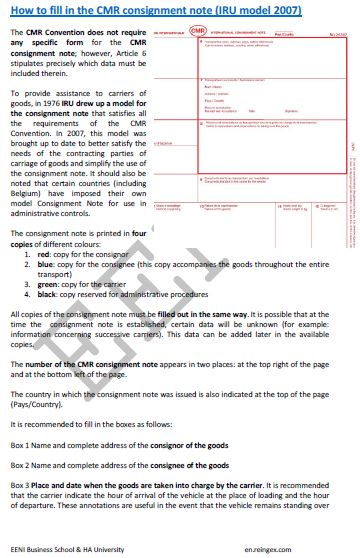International Road Transport Union

TIR Convention. International road transport facilitation
- Introduction to the International Road Transport Union (IRU)
- International road transport facilitation
- TIR Convention of the International Road Transport Union (IRU)
- Customs Convention on the International Transport of Goods under Cover of the TIR Carnets
- New TIR Convention (Adapted for intermodal transport)
- Convention on the Contract for the International Carriage of Goods by Road (CMR), United Nations
- IRU Guidelines for transport operators on insurance matters
- Importance of the International Road Transport in the global economy
- Safe Load Securing for Road Transport

The Subject “International Road Transport Union (IRU)” belongs to the following Online Programs taught by EENI Global Business School:
Logistics Courses: Road transport, Multimodal transport, Transport in Africa.

Diplomas: Foreign Trade, International Transport.

Masters: International Transport, Transport in Africa, International Business, Foreign Trade.
Doctorate: Global Logistics, World Trade.
Languages: 
 Organización Internacional Transporte por Carretera
Organización Internacional Transporte por Carretera
 Organization mondiale du transport routier
Organization mondiale du transport routier  União Internacional dos Transportes Rodoviários.
União Internacional dos Transportes Rodoviários.

International Road Transport Union (IRU).
The International Road Transport Union (IRU) is the responsible for managing globally the cargo and the people related to the transport sector, as well as creating the rules and conventions for the road transport:
- 1949: TIR Convention (Transports Internationaux Routiers)
- 1956: Convention on the Contract for the International Carriage of Goods by Road (CMR). Definition of the responsibilities of the carriers
- 1975: New TIR Convention (Adapted for the intermodal transport)
- 2008: protocol to the CMR Convention (use of the electronic consignment note)
Sample - International Road Transport Union (IRU)

Member countries of the International Road Transport Union (IRU): Afghanistan, Albania, Argentina, Armenia, Australia, Austria, Azerbaijan, Belarus, Belgium, Bosnia and Herzegovina, Brazil, Bulgaria, Canada, Chile, Colombia, Croatia, Cyprus, Czech Republic, Denmark, Egypt, Estonia, Finland, France, Georgia, Germany, Greece, Hungary, India, Iran, Iraq, Ireland, Israel, Italy, Japan, Jordan, Kazakhstan, Kuwait, Kyrgyz Republic, Latvia, Lebanon, Lithuania, Luxembourg, Macedonia, Malta, Mexico, Moldova, Mongolia, Montenegro, Morocco, Nepal, Netherlands, New Zealand, Norway, Oman, Pakistan, Poland, Portugal, Qatar, Romania, Russia, Saudi Arabia, Singapore, Serbia, Slovakia, Slovenia, Spain, South Korea, Sweden, Switzerland, Syria, Tajikistan, Tunisia, Turkey, Turkmenistan, UK, the U.S., Ukraine, UAE, Uzbekistan, Yemen.
The headquarters of the International Road Transport Union is in Brussels (Belgium), it was created in 1948.
The International Road Transport Union (IRU) is made up of local associations and road transport operators from more than 100 countries.
IRU International Guidelines on Safe Load Securing for Road Transport

The BIC Code (International Identification Codes of Container Owners) is accepted by the International Road Transport Union:
See also:- Trade Facilitation - Trade Facilitation Agreement - Kyoto Convention - Convention Harmonization of Frontier Controls of Goods (UNECE)
- Road-Rail Combined Transport
- Rotterdam Rules


Economic Corridors:
- Eurasian Land Transport Initiative (China-Europe)
- Almaty-Bishkek Corridor
- Bangladesh-Myanmar Corridor
- China-Russia Corridor
- China-Pakistan Corridor
- China-Central-West Asia Corridor
- India-Afghanistan Corridor
- Europe-Caucasus-Asia Corridor
- Corridor of the Ashgabat Agreement
- Trans-Siberian Railway (Russia, North Korea)
- North-South Corridor (India-Russia)
- Afghanistan-Turkey Corridor
- Trans-Caspian Corridor
- East-West Corridor (Myanmar-Vietnam)
- Kyrgyzstan-Iran Corridor
- Islamabad-Istanbul Corridor
- Nanning-Singapore Corridor

- Atlantic Corridor
- Baltic-Adriatic Corridor
- North Sea-Baltic Corridor
- North Sea-Mediterranean Corridor
- Mediterranean Transport Corridor
- Eastern Europe-Eastern Mediterranean Transport Corridor
- Scandinavian-Mediterranean Transport Corridor
- Rhine-Alpine Transport Corridor
- Rhine-Danube Transport Corridor
- Strasbourg-Danube Transport Corridor
- Pan-European Corridor II
- Pan-European Corridor IX
(c) EENI Global Business School (1995-2024)
We do not use cookies
Top of this page



